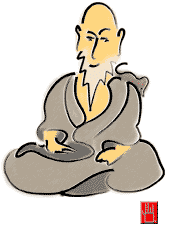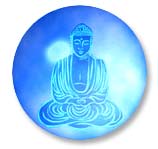On The Way: The Daily Zen Journal
Recommending Zazen to all People
Dogen (1200-1253)

The real way circulates everywhere; how could it require practice or enlightenment? The essential teaching is fully available; how could effort be necessary? Furthermore, the entire mirror is free of dust; why take steps to polish it? Nothing is separate from this very place; why journey away?
And yet, if you miss the mark even by a strand of hair, you are as distant as heaven from earth. If the slightest discrimination occurs, you will be lost in confusion. You could be proud of your understanding and have abundant realization, or acquire outstanding wisdom and attain the way by clarifying the mind. Still, if you are wandering about in your head, you may miss the vital path of letting your body leap.
You should observe the example of Buddha Shakyamuni of the Jeta Grove, who practiced sitting up straight for six years even though he was gifted with intrinsic wisdom. Still celebrated is Master Bodhidharma of the Shaolin Temple, who sat facing the wall for nine years although he had already received the mind seal. Ancient sages were like this; who nowadays does not need to practice as they did?
Hence, you should stop searching for phrases and chasing after words. Take the backward step and turn the light inward. Your body-mind of itself will drop off, and your original face will appear. If you want to attain just this, immediately practice just this.
For zazen, a quiet room is appropriate. Drink and eat in moderation. Let go of all involvements and let myriad things rest. Do not think good or bad. Do not judge right or wrong. Stop conscious endeavor and analytic introspection. Do not try to become a buddha. How could being a buddha be limited to sitting or not sitting?
In an appropriate place for sitting, set out a thick mat and put a round cushion on top of it. Sit either in the full or half-lotus posture. Loosen the robes and arrange them in an orderly way. Then place the right hand palm up on the left foot, and the left hand on the right hand, lightly touching the ends of the thumbs together.
Sit straight up without leaning to the right or left and without bending forward or backward. The ears should be in line with the shoulders and the nose in line with the navel. Rest the tongue against the roof of the mouth, with lips and teeth closed. Keep the eyes open and breathe gently through the nose.
Having adjusted your body in this manner, take a breath and exhale fully, then sway your body to left and right. Now sit steadfastly and think not-thinking. How do you think not-thinking? Beyond thinking. This is the essential art of zazen.
The zazen I speak of is not learning meditation. It is simply the dharma gate of enjoyment and ease. It is the practice-realization of complete enlightenment. Realize the fundamental point free from the binding of nets and baskets.
Once you experience it, you are like a dragon swimming in the water or a tiger reposing in the mountains. Know that the true dharma emerges of itself, clearing away hindrances and distractions.
When you stand up from sitting, move your body slowly and rise calmly, without haste. We understand from past precedents that going beyond ordinary and sacred, where sitting and standing are effortless and boundless, depends solely on the power of zazen.
Furthermore, bringing forth the turning point by using a finger, a pole, a needle, or a mallet, or leading people to enlightenment with a whisk, a fist, a stick, or a shout cannot be understood by discriminatory thinking. How can it be understood by the use of supernatural powers? Zazen is an awesome presence outside form and color. How is it not the path preceding concept?
Thus, do not be concerned with who is wise and who is stupid. Do not discriminate the sharp from the dull. To practice whole-heartedly is the true endeavor of the way. Practice-realization is not defiled with specialness; it is a matter for every day.
for every day.
Now, in this world and in other worlds, in India and China, buddha ancestors equally carry the buddha seal and teach the practice of sitting immersed in steadfastness.
Although circumstances may vary in a thousand ways, whole-heartedly practice Zen, giving yourself fully to the way. Why give up the sitting platform of your own house and wander uselessly in the dust of a remote land? Once a wrong step is taken, you depart from the way.
Having received a human life, do not waste the passing moments. Already upholding the buddha way, why would you indulge in the sparks from a flint? After all, form is like a dewdrop on the grass. Human life is like a flash of lightning, transient and illusory, gone in a moment.
Honored practitioners of Zen, please do not grope for the elephant or try to grasp the true dragon. Strive to hit the mark by directly pointing. Revere the mind that goes beyond study and surpasses all doings.
Experience the enlightenment of the buddhas, correctly inheriting the samadhi of the ancestors. Practice thusness continuously, and you will be thus. The treasury will open of itself for you to use as you wish.
Dogen (1200-1253)
Excerpted from Enlightenment Unfolds Kazuaki Tanahashi
Now, all ancestors and all buddhas who unfold buddha-dharma have made it the true path of enlightenment to sit upright practicing in the midst of self-fulfilling samadhi. Those who attained enlightenment in India and China followed this way. It was done so because teachers and disciples personally transmitted this excellent method as the essence of the teaching.
In the authentic tradition of our teaching, it is said that this directly transmitted, straightforward buddha-nature is the unsurpassable of the unsurpassable. From the first time you meet a master, without engaging in incense offering, bowing, chanting Buddha’s name, repentance, or reading scriptures, you should just wholeheartedly sit, and thus drop away body and mind.
Excerpted from Essential Zen, Kazuaki Tanahashi and David Schneider




To “just wholeheartedly sit” is perplexing to many newcomers to Zen. We have received many letters from readers asking for instruction on how to sit. This summer we will be offering teachings from some of the respected masters in meditation from ages past.
The first selection above is from Dogen Kigen founder of the first Zen monastery in Japan and exceptional contributor to the literature of Zen. Rejecting all other practices as secondary, Dogen promoted zazen as the “front gate” of the Dharma open to all regardless of intelligence, class, or gender.
With Pure Intention,
Elana, Scribe for Daily Zen